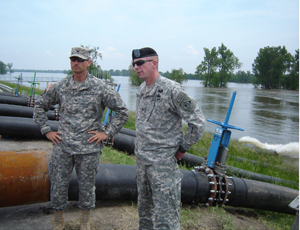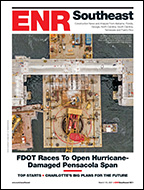

When it seemed inevitable that record flooding would prompt the U.S. Army Corps of Engineers to blow three sections of levee and open the Birds Point-New Madrid floodway this past spring, Corps communicators sprang into action to “revolutionize” their use of social media, says Scott Whitney, regional flood-risk manager for the Corps’ Mississippi Valley Division.
“We broke the barriers on how we deal with the public. This was the first time social media—Facebook, specifically—was used in a flood fight for ongoing communications with the public and media,” Whitney says.
At 9 a.m. on April 30, the Corps set up a Facebook page dedicated solely to the Birds Point-New Madrid floodway. “Four hours later, we had 700 followers,” says Stephen Rochette, a public-affairs officer from the Philadelphia District who coordinated the effort.
The number grew to 2,000 by the end of the day, and within six days, 16,000 people from 32 countries had “liked” the page. About a month after the floodway was opened on May 2, the Corps’ Facebook page had received six million post views and thousands of posted comments and questions.
Rochette says Corps districts across the country have used Facebook and Twitter “for several years” to post information about routine events and projects. “This case was so extraordinary because people were craving information, and we knew it was a good tool to reach people quickly,” he says.
Rather than merely providing an alternate conduit for disseminating the Corps’ message, Facebook and Twitter gave the Corps “real-time ability to talk to the public and media to dispel myths that were developing,” Whitney says.
Earthquake Rumor
Rumors were rampant, including one that detonation of a two-mile stretch of levee would cause an earthquake along the New Madrid fault line. A representative from the U.S. Geologic Survey quickly dispelled that myth by posting an accurate, informed reply on the Corps’ Facebook page.
“We had our partners posted on the page—the USGS, Coast Guard, Red Cross and representatives from municipalities and states. Basically, everyone who was with us in the joint information center was incorporated into the page,” Rochette says. “It was a way to get to people immediately on their smart phone or computer. We went directly to them, so they didn’t have to go to a website to find information.
From the USACE Memphis District Joint Information Center in Sikeston, Mo., the Corps and other agencies were able to communicate quickly with the public and, as official sources, clarify information, quash fears and waylay rumors. The page also served as a public forum in which people engaged about what was happening, Rochette says. If someone posted a question that the Corps had previously answered, some Facebook friend would invariably refer that person back to the original reply.
The page grew so quickly—including photos, reports and video clips—that its 24-hour maintenance became the primary job for at least two people. “I think our experience reinforces the fact that Facebook is a very powerful tool,” Rochette says. “In an emergency, the biggest priority is getting accurate information out quickly.”
The Corps is hoping to capture lessons learned from the success and apply them to social-media operations elsewhere. The Birds Point-New Madrid team is getting feedback from stakeholders and developing a white paper to be delivered to USACE headquarters by mid- to late November, Whitney says.


Post a comment to this article
Report Abusive Comment